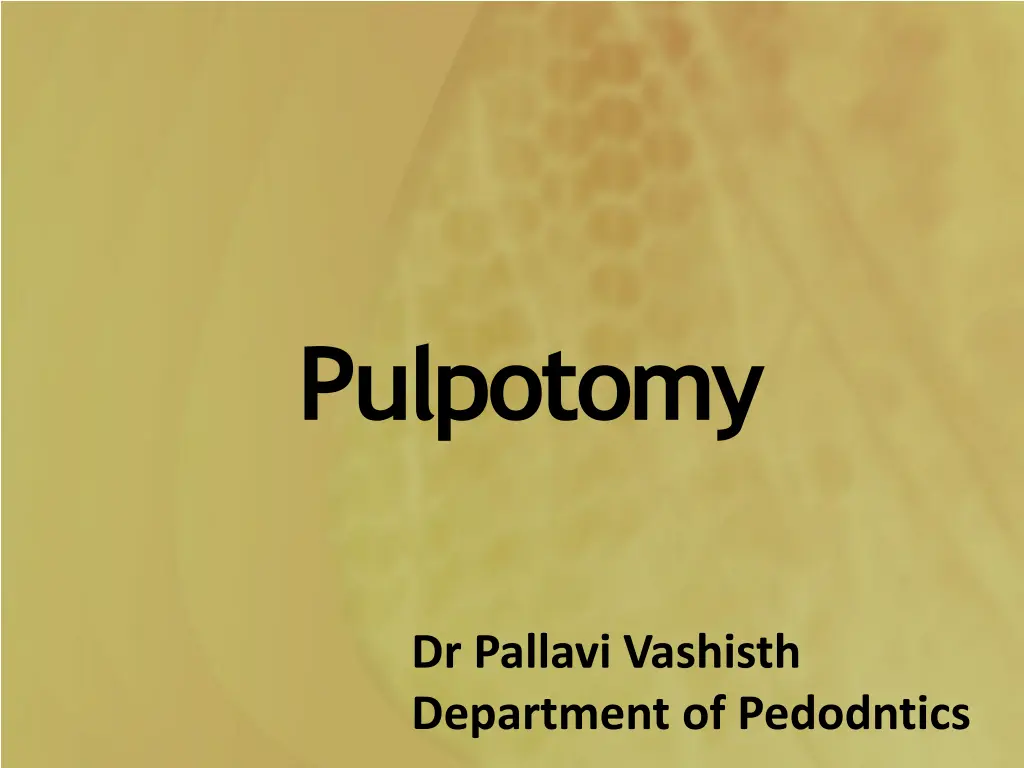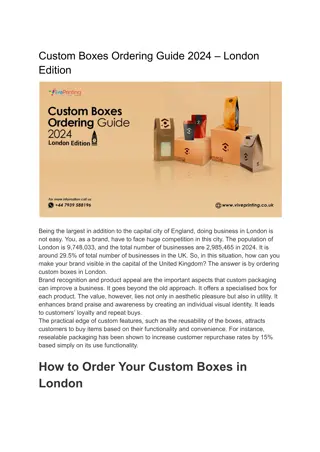
Pulpotomy Procedure for Primary Teeth - Indications, Contraindications, and Technique
Explore the pulpotomy procedure for primary teeth, including indications, contraindications, and the appropriate technique. Learn about the importance of accurate diagnosis, coronoal pulp amputation, and post-treatment care for successful outcomes in pediatric dentistry.
Download Presentation

Please find below an Image/Link to download the presentation.
The content on the website is provided AS IS for your information and personal use only. It may not be sold, licensed, or shared on other websites without obtaining consent from the author. If you encounter any issues during the download, it is possible that the publisher has removed the file from their server.
You are allowed to download the files provided on this website for personal or commercial use, subject to the condition that they are used lawfully. All files are the property of their respective owners.
The content on the website is provided AS IS for your information and personal use only. It may not be sold, licensed, or shared on other websites without obtaining consent from the author.
E N D
Presentation Transcript
Pulpotomy Dr Pallavi Vashisth Department of Pedodntics
Pulpotomy The surgical removal of the coronal portion of a vital pulp as a means of preserving the vitality of the remaining radicular portion. short-term success rates are favourable This procedure is generally advocated for deciduous teeth Success of pulpotomy is largely dependent on the diagnosis of residual pulp to be healthy or reversible inflammed facebook.com/notesdental
Indications Pulp exposure on primary teeth in which the inflammation or infection is diagnosed to be confinedto the coronal pulp If inflammation hasspread into the tissues within the root canals pulpectomy or root canal filling or extraction.
Contraindication of Pulpotomy 1. A history of spontaneous toothache (not caused by papillitis resulting from food impaction) Nonrestorable tooth where postpulpotomy coronal seal would be inadequate A tooth near to exfoliation or if no bone overlies the crown of the permanent successor tooth Evidence of periapical or furcal pathosis Evidence of pathologic root resorption pulp that does not bleed (necrotic) Inability to control radicular pulp hemorrhage following a coronal pulp amputation A pulp with serous or purulent drainage Presence of a sinus tract 2. 3. 4. 5. 6. 7. 8. 9.
Technique accurate diagnosis of pulp status is very important in aiding appropriate pulpal management An accurate pain history Radiographic findings Clinically, success of vital pulp therapy in the primary dentition dependsupon: effective control of infection. Complete removal of inflamed coronal pulp tissue. Appropriate wound dressing. effective coronal seal during and after treatment
Coronal Pulp Amputation After complete isolation andunder L.A., complete removal of caries is done Unroofing of pulp chamber with non-cutting high speed burunder copious waterirrigation bleeding indicates vital (if inflamed) coronal pulptissue coronal pulp is amputated with a slow-speed #6 or #8 round bur or spoon excavator Care is taken not to leave a single strain of filament of coronal pulp bleeding impossible tocontrol
Coronal Pulp Amputation Thoroughly washed with sterile water or saline to remove all debris, and the site is dried by vacuum and sterile cotton pellets Hemorrhage should be controlled in this manner within 3 minutes, but if bleeding persists check that all filaments of the pulp were removed from the pulp chamber the amputation site is clean. If after doing this hemostasis is not achieved within 2 to 3 minutes, then tooth is not a candidate of pulpotomy Pulpectomy or tooth should be extracted
Coronal Pulp Amputation Once bleeding has stopped at the radicular pulp stumps, either of the following technique dilute formocresol solution for 5 minutes 15% ferric sulfate solution for 15 seconds MTA pulpotomy electrosurgical pulpotomy Laser pulpotomy
Formocresol Pulpotomy Formocresol Solution Full-Strength Buckley s Formocresol : Formaldehyde 19%, Tricresol 35%, Glycerin 15%, Water 31% One-Fifth Dilution of Formocresol Solution: 1 part Buckley s formocresol solution + 1part distilled water and 3 part glycerin one-fifth dilution formocresol solution on a cotton pellet is blotted to remove excess formocresol and then placed in direct contact with the pulp stumps for 5 minutes pellet is removed - tissue appears brown A cement base of ZOe is placed over the pulp stumps and allowed to set tooth may then be restored permanently
Formocresol Pulpotomy Toxic and corrosive, especially at the point of contact Increased penetration radicularroot FAD is genotoxic, inducing mutations and DNA damage fear of damage to the succedaneoustooth Unlike the tissue response to Ca(OH)2, no dentin bridge should be anticipated after applying formocresol to exposedpulp tissue narrowing of the root canal through the continued deposition of dentin by the preserved radicular pulp may be observed in some case
Prognosis internal resorption - formocresol wasapplied accompanied by external resorption, May becomes excessively mobile; a sinustract Rare occurrence of pain so formocresol failure can be detected only clinically detected by chance The development of cystic lesions is evidencedin some cases Above findings emphasize the importance of periodic follow-up to endodontic treatment on primaryteeth
GlutaraldehydePulpotomy Glutaraldehyde has been a suggested alternative to formocresol as a tissue fixative little toxic effect antigenic action similar to formocresol, it is of a lower potential unstable increasing failure rates
Ferric Sulfate Pulpotomy After completion of coronal pulp amputation and achievement of hemostasis with moist cotton pellets, a 15.5% solution of ferric sulfate is applied to the radicular pulp stumps for 10 to 15 seconds small droplets of the solution to drip from a burnisher tip onto the surface of the pulp tissue dento-infuser tip for this purpose
Ferric Sulfate Pulpotomy hemostatic agent blood reacts with ferric and sulfate ions within the acidic pH of the solution form plugs that occlude the capillary orifices and prevent blood clot formation hemostatic agent during the Ca(OH)2 pulpotomy
A, extensive dental caries affecting a mandibular first primary molar. note proximity of radiographic lesion to the mesial pulp horn. B, Caries removal showing a carious pulpal exposure; bleeding is evident. C,Partial unroofing of the pulp chamber; note bleeding coronal pulp prior to amputation. D,Roof of pulp chamber removed completely. E, 15.5% solution of ferric sulfate is applied to radicular pulp stumps using a dento- infuser tip supplied by the manufacturer. F,Hemostasis is evident at radicular pulp stumps. G,Definitive restoration involves placement of zinc oxide eugenol, overlaid with glass ionomer intracoronally, followed by a preformed metal (stainless steel) crown facebook.com/notesdental
Mineral Trioxide Aggregate Pulpotomy MTA powder is mixed with sterile water until the powder is adherent excess moisture is removed from the powder by placing a dry paper point into the mixture to act as a moisture wick. Using an excavator or retrograde amalgam carrier - depth of 3 to 4 mm Gently packed by blunt end of a large paper point and a broad ended amalgam compactor.
Mineral Trioxide Aggregate Pulpotomy ZOe or glass ionomer cement is placed gently over the MTA andallowed to set It takes several hours to reach its optimum physical strength, once its set the cavity is restored with permanentrestoration pulp tissue responses to MTA to be superior to those produced using Ca(OH)2
Electrosurgical Pulpotomy large sterile cotton pellets are placed in contact with the pulp, and pressure is applied to obtain hemostasis The Hyfrecator Plus 7-797 - set at 40% power (high at 12 W) The cotton pellets are quickly removed, and the electrode is placed 1 to 2 mm above the pulpal stump Heat and electrical transfer are minimized by keeping the electrode as far away from the pulpal stump and tooth structure as possible while still allowing electric arcing to occur. may be repeated up to a maximum of three times dry and completely blackened ZOE applied and restored as earlier facebook.com/notesdental
Electrosurgical Pulpotomy coagulation, or electrofulguration can occur carbonizes and denatures pulp tissue, producing a layer of coagulative necrosis. acts as a barrier between the lining material and healthy pulp tissue below produced results comparable to those found with the use offormocresol
Laser Pulpotomy carbon dioxide laser for performing vital pulpotomies on primary teeth viable alternative to formocresol the carbon dioxide laser appeared to compare favorably with formocresol treatment Clinical trials still under way
PARTIAL PULPOTOMY Cvek pulpotomy the surgical removal of a small portion of the coronal portion of a vital pulp as a means of preserving the remaining coronal and radicular pulp expose deeper, healthy coronal pulp tissue Direct pulp capping and partial pulpotomy are considered similar procedures and differ only in the amount of undestroyed tissue remaining after treatmen
Partial pulpotomy immature teeth which have been subject to pulp exposing trauma 1- to 2-mm deep cavity is prepared into the pulp, using a high-speed handpiece with a sterile diamond bur of appropriate size with copious water coolant pulp is amputated deeper until only moderate hemorrhage is seen 5% sodium hypochlorite (NaOCl; bleach) has been recommended - chemical amputation of the blood coagulum, remove damaged pulp cells, dentin chips, and other debris, and provides hemorrhage cfo acenbotork.o coml/notesdental
PartialPulpotomy Care must be taken not to allowa blood clot to develop Thin layer of pure calcium hydroxide is mixed with sterile saline or anestheticsolution to a thick mix and carefully placed onto the pulp stump Alternatively MTA can be used. Cavity preparation is filledwith GIC. Exposed dentin is acid-etched Composite is applied facebook.com/notesdental
Followup Evidence of maintenance of responses sensitivity tests radiographic evidence of continued root development a) pre-op b) peri-op c) 6 months post-op to


